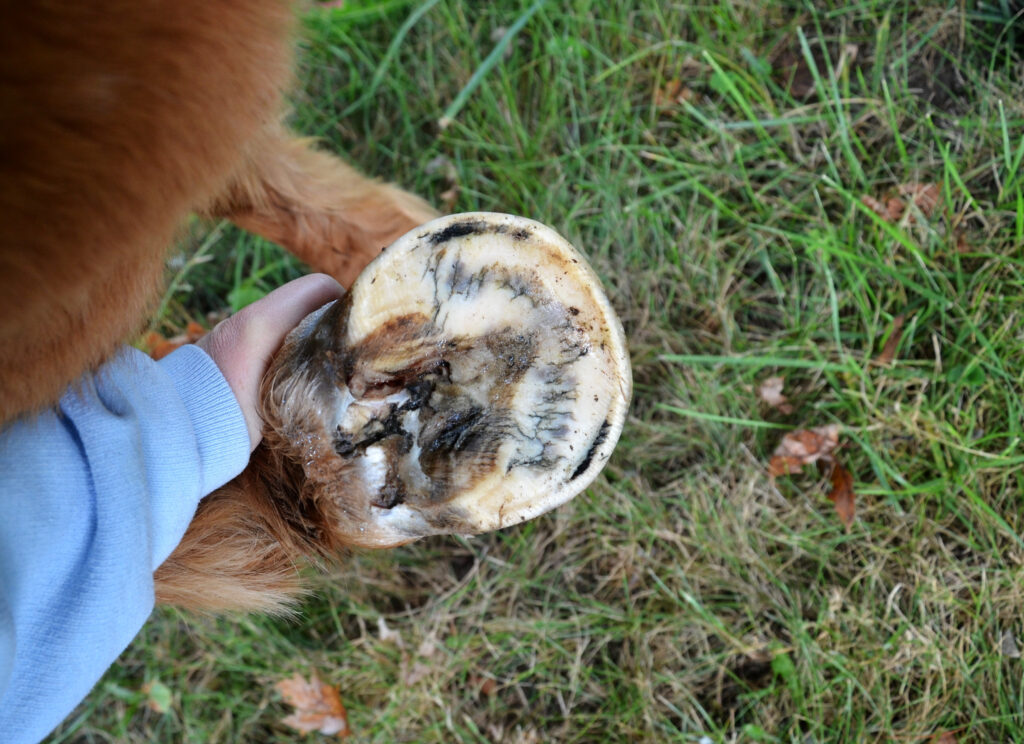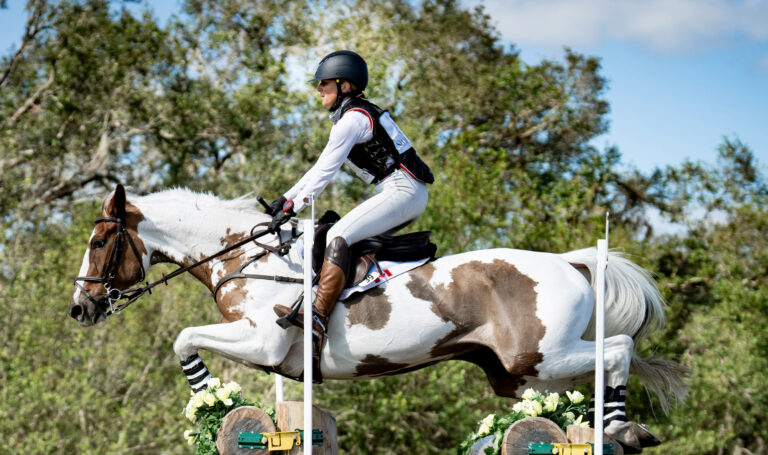What It Is
Thrush is the degradation and weakening of the insensitive tissue of the frog—the triangular-shaped structure on the underside of the hoof. It occurs when various anerobic microbes infiltrate and multiply in susceptible areas of the frog, usually starting in the sulci (the deeper clefts located on either side of and in the center of the frog).
What’s at Stake
A horse can become lame in severe cases. Also, if the frog is weakened enough that bleeding tissue becomes exposed, it can lead to widespread infection of the hoof.
Cause
Various microbes are associated with thrush. Historically, the most common one cultured is Fusobacterium necrophorum, a bacterium that occurs naturally in a horse’s environment and thrives in airless, moist conditions, such as the underside of a hoof that’s packed with mud and manure.

Contributing Factors
Consider this: The structure and function of a normal hoof promote the ability to self-clean. The hoof is not a completely rigid structure: With each step, the hoof wall and heels expand and contract, and the sole flexes when weight-bearing. That bit of movement can be enough to push out material that’s become lodged. Anything that disrupts the self-cleaning function or actions (more likely, inactions) that enable bacteria to invade and multiply increase the risk of thrush. The list includes:
• wet, muddy and/or unsanitary footing in a horse’s turn out area
• unhygienic conditions in a stall
• hit-or-miss hoof cleaning: for instance, sporadic picking sessions or efforts that end before accumulated debris is thoroughly cleared away
• insufficient movement or excessive time spent in a stall
• lapses in scheduled farrier visits, resulting in overgrown and unbalanced hooves
• a diet lacking in nutrients to promote overall health and well-being.
A horse’s susceptibility to thrush may also be related to:
• genetic predisposition to poor hoof quality
• suboptimal hoof conformation
• previous hoof disease that affects the ability to grow normal frog tissue.
Signs
Early signs of thrush are unmistakable:
• thick, black discharge oozing from the affected area
• pungent, foul odor
• ragged edges on the frog.
As the infection progresses, it can also:
• make the frog appear smaller as pieces pull away
• cause the loss of insensitive tissue
• diminish the body’s ability to protect deeper, sensitive tissue, making the area painful and often causing it to bleed.
Symptoms
In the early stages, a horse may seem unaffected by thrush. But longer term, as the infection becomes more deeply seated, he may show signs of pain. For instance, he pulls his leg away during hoof cleaning or he reluctantly walks over gravel and other uneven or hard surfaces.
The longer thrush goes untreated, the more difficult it is to bring under control. A mild to moderate infection may resolve in a week or two with treatment. But it takes time to regrow frog tissue: one to two months for the outermost layers; four to six months to produce an entirely new frog.

Situations that enable bacteria to invade and multiply increase the risk of thrush. This includes wet and muddy footing in a horse’s turn out area. ©Sandra Oliynyk
Treatment
Medical: A veterinarian can confirm that a horse has thrush and determine the extent of the infection. In most cases, the prognosis for a full recovery is good. For a mild to moderate case, treatment typically includes:
• trimming the frog to remove tissue that is exfoliating or harboring microbes
• cleaning the infected area daily with a hoof pick and perhaps a soft brush and cotton swabs to get into the tight crevices
• applying a commercial topical anti-thrush treatment that contains either iodine or a copper-based product. It’s important to follow package directions.
• applying a commercial topical product to harden the frog
• waiting for any hoof treatment to dry before turning out a horse
• staying on schedule with farrier visits to keep all hooves properly trimmed and balanced and return the affected foot to its normal function.
Additional measures will be necessary when an infection is more serious. They may include:
• administering oral or injectable antibiotics if dermis is exposed
• providing additional protection: a bandage, medicated packing under a pad or a hoof boot.
Management: No amount of medical intervention will have a lasting effect if the horse isn’t kept in a clean, dry environment. So, be mindful of footing conditions and maintain hoof health with daily picking and regular attention from a farrier.
Prevention
These additional measures can help reduce the likelihood a horse will develop thrush:
• Pay attention to the weather to be aware of periods with wet and muddy footing.
• Identify trouble spots in the pasture and beyond and take steps to manage mud. Take note of low-lying or high-traffic areas that might benefit from the addition of sand, sawdust or gravel.
• Keep the stall clean, dry and well bedded.
• Provide plenty of turnout time and exercise to help support the hoof’s ability to self-clean.
• Feed a diet with good nutrition.

Lydia Mudd, DVM, CF, is an equine veterinarian at Janssen Veterinary Clinic, in Sheridan, Indiana. A 2014 graduate of the University of Illinois College of Veterinary Medicine, she enjoys all aspects of equine practice, but has a special interest in podiatry. Dr. Mudd has earned the title of Certified Farrier (CF) through the American Farrier’s Association and stays active in the local farrier community. She notes that weather conditions in her locale contribute to an uptick in thrush cases during the spring, fall and winter.











